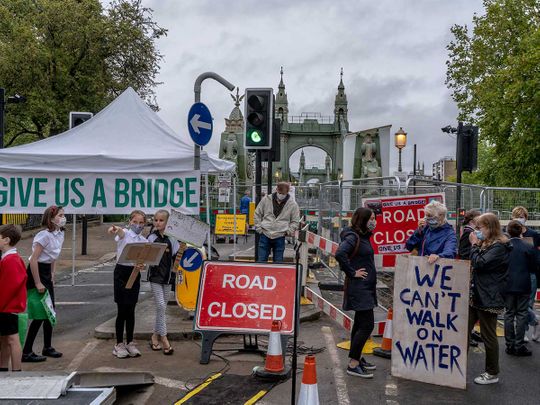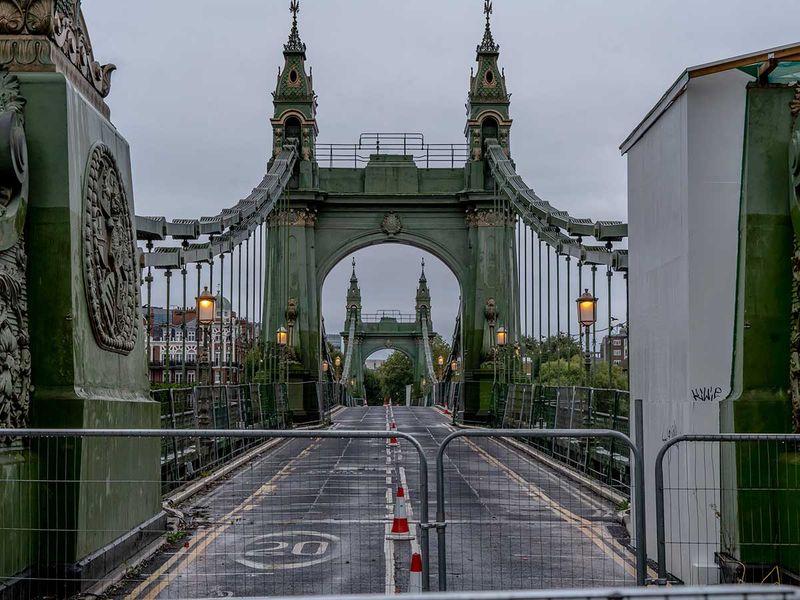
London: One by one, they stepped forward to tell their stories. Children suddenly forced to travel two hours each way to school. Pensioners whose weekly doctors’ appointments have turned into arduous, half-day treks. Shopkeepers whose businesses have been crippled by the disappearance of commuters.
All because Hammersmith Bridge, a majestic but badly corroded 19th-century suspension bridge that connects the district of Barnes with much of London, was closed last month for safety reasons.
“Now, I need to wake up at quarter past 6, every day, six days a week,” said Aston Jenkins, 10, drawing sympathetic groans from the frustrated, if exceedingly polite, crowd protesting recently at the bridge. “I can’t cope with that.”
While Hammersmith Bridge’s structural problems are particularly dire, it is far from the only London bridge that is crumbling. Two major crossings in the city centre, Vauxhall Bridge and London Bridge, are closed to car traffic while they receive urgent repairs. Tower Bridge, the very symbol of London, was closed for two days last month after a mechanical glitch jammed its drawbridge open.
It fell to a young schoolgirl - outfitted in a red cardigan and patent-leather Mary Janes, and brandishing a placard with angry pink letters - to make the inevitable point: “London Bridges are falling down!”
Philip Englefield, a professional magician who lives in Barnes, pointed out that when a suspension bridge collapsed in Genoa, Italy, in 2018, killing 43 people, the Italians worked tirelessly, even as the country battled the coronavirus pandemic, to build a replacement. It was inaugurated last month.

“Why can’t we do that?” Englefield asked the crowd, as a gentle rain further dampened their spirits. “For goodness’ sake, this is England.”
It turns out that is precisely the problem: Hammersmith Bridge is an apt metaphor for all the ways the country has changed after a decade of economic austerity, years of political wars over Brexit, and months of lockdown to combat the pandemic, the last of which has decimated already-stressed public finances.
Neglected for decades
Like other London roads and bridges, Hammersmith Bridge had been neglected for decades. Fully repairing it would cost an estimated 141 million pounds ($187 million) - funds that neither Hammersmith & Fulham Council, which owns the bridge, nor London’s transportation authority, which depends on it, currently have.
Transport for London, which runs the subway and bus system and some major roads, has already had to negotiate a nearly 2 billion pound bailout from the government to make up for a shortfall in revenue after ridership plummeted during the lockdown. Except for rush hour, London’s subways are still largely ghost trains.
Hammersmith has appealed for help to Prime Minister Boris Johnson. But Johnson won election by promising to spend money on marquee projects like a $130 billion-plus high-speed railway, not a cast-iron relic of Queen Victoria’s reign.
Spread the wealth
He also wants to spread the wealth to Britain’s economically challenged Midlands and North, not rescue a leafy, affluent enclave of London, where professionals commute from gracious Regency villas to jobs in the City and students practice on the manicured playing fields of the elite St. Paul’s School.
“The national government is afraid of spending money in London because it would threaten its ‘levelling up’ agenda,” said Tony Travers, an expert in urban affairs at the London School of Economics. “Promising to build shiny things for the future is more attractive than fixing road surfaces or mending bridges.”
It doesn’t help that the member of Parliament from Johnson’s Conservatives who represented the district that encompasses Barnes, Zac Goldsmith, lost his seat in the last election. Goldsmith, a well-connected friend of Johnson’s, had pledged to fix the bridge during his campaign. His successor, Sarah Olney, from the centrist Liberal Democrats, said she could not get any Cabinet ministers to answer her letters pleading for help.
Michael White, a former political editor at The Guardian who lives on the north bank of the Thames, pointed out a problem of asymmetry: Barnes, on the southern side, needs the bridge more than Hammersmith, on the northern side, because scores of its commuters cross it every day to reach the nearest Tube station. There is less traffic in the opposite direction, which makes an expensive repair job politically hard to sell for officials in less well-off Hammersmith.
Fractures widen
Still, the Labour Party leader of the council, Stephan Cowan, insisted that Hammersmith was fully committed to fixing the bridge - if it can find a financial lifeline. He credited the council with averting a potential calamity by hiring engineers to inspect the bridge in 2014. They found a web of tiny fractures in its cast-iron pedestals, evidence of untold years of corrosion.
In April 2019, authorities closed the bridge to cars, but left it open to pedestrians and cyclists. Then, after a recent heat wave, inspectors discovered that the fractures had widened. Because cast iron is more brittle than steel, those changes raised the danger that the pedestals could shatter, plunging the bridge into the Thames. The council immediately closed the bridge to everyone.
“If we hadn’t done the comprehensive integrity review,” Cowan said, “I genuinely believe we could have had a catastrophe.”
Other solutions
In the meantime, the locals are floating other solutions, like starting a ferry service or running shuttle buses. Some, like Toby Gordon-Smith, have resorted to roundabout routes across other bridges (there are more than a dozen road or pedestrian crossings between Hammersmith Bridge and Tower Bridge). Gordon-Smith, 46, who uses a wheelchair, said he chose to live in a riverfront apartment in Barnes because he could wheel himself across the bridge to his office in Hammersmith - 10 minutes door to door.
“This is an important place for me to live, to be able to access my work, to be able to access the rest of London,” he said.
For older people who came to the rally, the fragility of London’s bridges is more than just grist for a nursery rhyme. Christopher Morcom, 81, recalled that in 1967, an American entrepreneur, Robert McCulloch, bought the crumbling London Bridge, dismantled it, and transported it stone by stone to Lake Havasu City, Arizona, where it now sits as a tourist attraction in the desert. (The London Bridge currently undergoing work is a replacement for that 19th-century version.)
It all gave Morcom the germ of an idea. “I don’t know whether this old bridge is reparable,” he said, gesturing to Hammersmith Bridge. “Maybe we should sell it to the president of the United States.”








